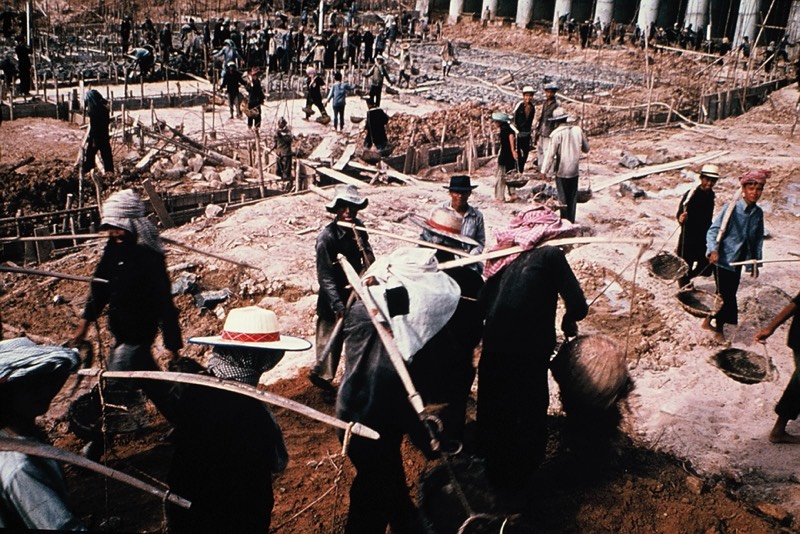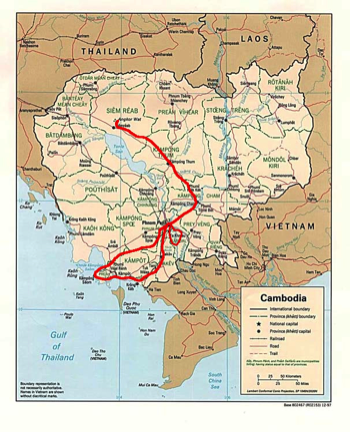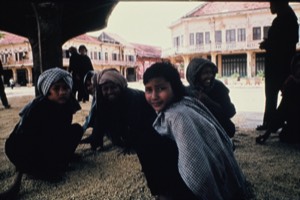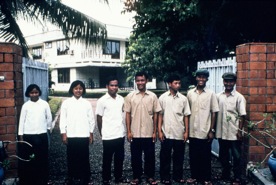Kambodja 1978 - a journey with blinders on

When the picture above was taken in 1978 I was mostly impressed. I saw a revolution that was a model for others: the emphasis was on irrigation and relying on your forces. Then plan was to move the country from poverty with a unique priority on rice production, irrigation and total equality.
Today I see a picture of slave labour. Nobody got to chose their work. There were no real possible for shade or rest under the hot sun. The work was unpaid except for a minimal food ration. The irrigation site was constructed at the prize of thousands of lives.
To believe in a ideology does not have to be wrong. The problem arises when it becomes a dogma and includes a view of the world that can´t be discussed or opposed. The ideology that guided me at this time is easiest to described as maoism. Different versions of marxism-leninism have been tried in different countries and always with horrible results. Cambodia 1975-79 was the most totalitarian state to exist in modern times. Communism in different forms has to be investigated - why does it always end up in disaster? There is a totalitarian strait built into the system. Communism is a an utopia - the dream of the perfect society. Pol Pot had a vision and there was no prize that was to high to reach that goal.
Today I see a picture of slave labour. Nobody got to chose their work. There were no real possible for shade or rest under the hot sun. The work was unpaid except for a minimal food ration. The irrigation site was constructed at the prize of thousands of lives.
To believe in a ideology does not have to be wrong. The problem arises when it becomes a dogma and includes a view of the world that can´t be discussed or opposed. The ideology that guided me at this time is easiest to described as maoism. Different versions of marxism-leninism have been tried in different countries and always with horrible results. Cambodia 1975-79 was the most totalitarian state to exist in modern times. Communism in different forms has to be investigated - why does it always end up in disaster? There is a totalitarian strait built into the system. Communism is a an utopia - the dream of the perfect society. Pol Pot had a vision and there was no prize that was to high to reach that goal.
How could we support Pol Pot and the Khmer Rouge?
At the time of the trip 1978 I supported Democratic Kampuchea in spite of all the reports about prosucetion and terror. I know better today and try to look back 30 years to understand how the support was possible. The way I see it today the trip should never have been made since it became part of the Khmer Rouge propaganda. I deeply regret my part in this. But I can´t turn back history. I can only learn from it and hope that this website, other discussions, debates and the readers own reflections can create a deeper understanding of this period of the Cambodian history. I also hope that we can try to understand how a twisted ideology can fool so many people, also those who believe that they are working for a good cause. We can learn not to put blinders on but instead see reality the way it is even when it does´t fit our ideology.
I was active in the antiwar movement against the American war in Vietnam (and also in Laos and Cambodia) from the 60´s until 1975. In the Khmer Rouge I saw a pure movement chat took no orders from the superpowers. I, and many in my generation, had a positive view of the Chinese revolution and Mao Zedong. When we read about the Cambodian revolution we thought we saw something even better: a society of equals, no oppression, no slavery and an experiment where they tried to avoid the mistakes of other revolutions. After a while we heard rumours of murder and oppression. We did not want to believe them.
Today I can see that, already before our trip, there was proof enough that the Cambodian revolution was a story including a lot of murders, executions, torture and oppression. I did not want to realize this. And then we were invited to see with our own eyes. The pictures you seen on this website is part of what we saw. Of course we were not taken to Tuol Sleng prison (it was a secret prison). We witnessed no brutality. But we didn´t speak Khmer, we were dependent on our Cambodian hosts. The trip had its limitations: we were never allowed to stay overnight in a village. But these pictures together with my maoist based prejudiced assumptions made me see what I wanted to see.
At the time of the trip 1978 I supported Democratic Kampuchea in spite of all the reports about prosucetion and terror. I know better today and try to look back 30 years to understand how the support was possible. The way I see it today the trip should never have been made since it became part of the Khmer Rouge propaganda. I deeply regret my part in this. But I can´t turn back history. I can only learn from it and hope that this website, other discussions, debates and the readers own reflections can create a deeper understanding of this period of the Cambodian history. I also hope that we can try to understand how a twisted ideology can fool so many people, also those who believe that they are working for a good cause. We can learn not to put blinders on but instead see reality the way it is even when it does´t fit our ideology.
I was active in the antiwar movement against the American war in Vietnam (and also in Laos and Cambodia) from the 60´s until 1975. In the Khmer Rouge I saw a pure movement chat took no orders from the superpowers. I, and many in my generation, had a positive view of the Chinese revolution and Mao Zedong. When we read about the Cambodian revolution we thought we saw something even better: a society of equals, no oppression, no slavery and an experiment where they tried to avoid the mistakes of other revolutions. After a while we heard rumours of murder and oppression. We did not want to believe them.
Today I can see that, already before our trip, there was proof enough that the Cambodian revolution was a story including a lot of murders, executions, torture and oppression. I did not want to realize this. And then we were invited to see with our own eyes. The pictures you seen on this website is part of what we saw. Of course we were not taken to Tuol Sleng prison (it was a secret prison). We witnessed no brutality. But we didn´t speak Khmer, we were dependent on our Cambodian hosts. The trip had its limitations: we were never allowed to stay overnight in a village. But these pictures together with my maoist based prejudiced assumptions made me see what I wanted to see.
This is how we travelled in 1978




An almost empty ghost town- Pnom Penh in August 1978
A cooperative in the South West
The bus tation in Kompong Cham was used to dry corn
